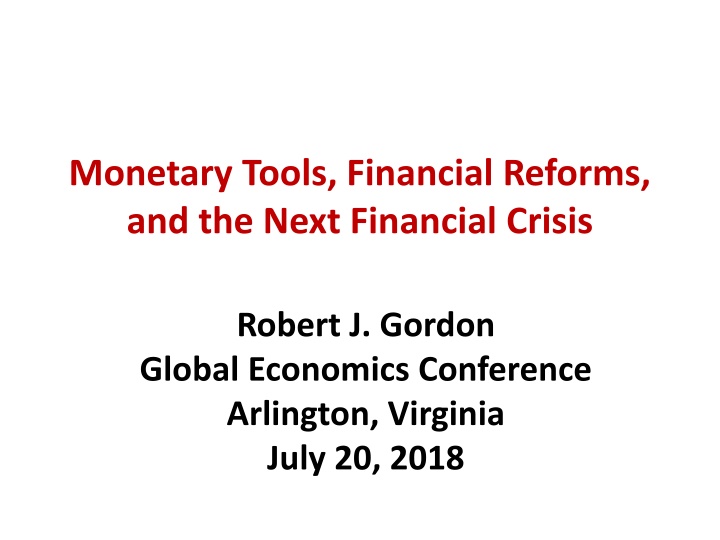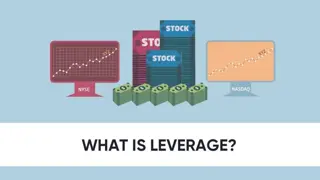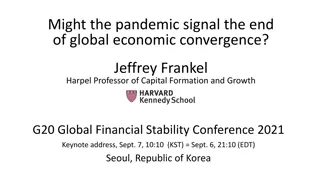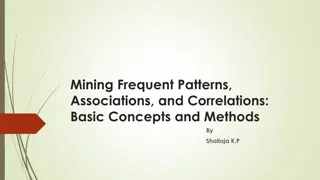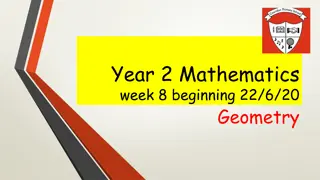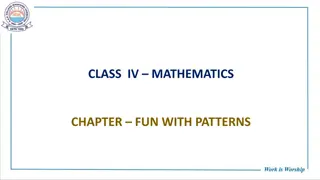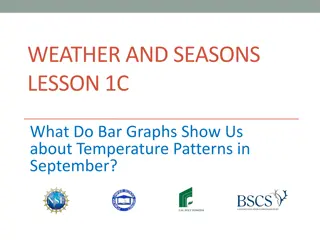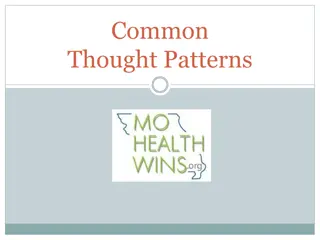Global Financial Trends and Historical Patterns
Delve into the insights on monetary tools, financial reforms, and the potential for another financial crisis based on historical data and future projections. Analyze U.S. crisis history, global financial reforms, and the dynamics shaping international monetary policy cooperation. Explore why another financial crisis may not be imminent, backed by detailed analysis of past crises and current global economic trends.
Download Presentation

Please find below an Image/Link to download the presentation.
The content on the website is provided AS IS for your information and personal use only. It may not be sold, licensed, or shared on other websites without obtaining consent from the author.If you encounter any issues during the download, it is possible that the publisher has removed the file from their server.
You are allowed to download the files provided on this website for personal or commercial use, subject to the condition that they are used lawfully. All files are the property of their respective owners.
The content on the website is provided AS IS for your information and personal use only. It may not be sold, licensed, or shared on other websites without obtaining consent from the author.
E N D
Presentation Transcript
Monetary Tools, Financial Reforms, and the Next Financial Crisis Robert J. Gordon Global Economics Conference Arlington, Virginia July 20, 2018
The Questions Posted to Me for this Presentation How will central banks and governments use monetary tools in the next financial crisis? What are your thoughts on the state of global financial reforms and/or global responses to US financial reforms? What do you see as the future of international monetary policy cooperation?
The First Question Starts From the Wrong Premise How will central banks and governments use monetary tools in the next financial crisis? There is not going to be a next financial crisis My starting point: to convince you to stop worrying about the next crisis Change of topic: adequacy of monetary tools for the next recession When are we going to have the next recession?
Why Were Not Going to Have Another Financial Crisis There can t be a global financial crisis without a crisis in the U.S., and there won t be a crisis in the U. S. Previous foreign financial crises that had no impact on the U. S. Mexico 1994 East Asia 1997-98 Instability in major nations that did not affect U.S. Gyrations in Chinese stock market 2013 Euro crisis, second wave of high unemployment in Europe
U. S. Crisis History: Only Two U.S. Crises Since 1907 1929: Stock market fell by half in one month, but this isn t enough to explain Great Depression Monetary ineptness, money supply declined by 1/3 25,000 banks failed Overbuilding in 1920s sapped demand for investment in 1930s, especially for housing 2008: What were the ingredients? Housing price bubble Sub-prime mortgages bundled into mortgage-backed securities Overlevered shadow banks which became insolvent when MBS were marked to market 2000-2001? Stock market fell by half but no crisis
S&P Price Earnings Ratio, 1900-1948 220 200 180 160 140 S&P/Earnings (Index 1925= 100) 120 100 80 60 40 20 0 1900 1903 1906 1909 1912 1915 1918 1921 1924 Year 1927 1930 1933 1936 1939 1942 1945 1948
Housing Starts Relative to Households, 1920-41 vs. 2000-2018 4.0 3.5 3.0 2.5 2.0 1.5 1.0 0.5 0.0 1920/2000 1924/2004 1928/2008 1932/2012 1936/2016 1940 1920 2000
S&P Price-Earnings Ratio, 1970-2018 200 180 160 140 S&P/Earnings (Index 1995 = 100) 120 100 80 60 40 20 0 1970 1973 1976 1979 1982 1985 1988 1991 1994 Year 1997 2000 2003 2006 2009 2012 2015 2018
The 2003-06 Housing Bubble Stands Out: House Price/Rent Ratio 1970-2018 160 140 Housing Price over Rental Price 120 100 80 60 1970 1973 1976 1979 1982 1985 1988 1991 1994 Year 1997 2000 2003 2006 2009 2012 2015 2018
When Will the Next Recession Come? Factors to Consider Monetary Policy: How Restrictive? Tax Cuts and Reform: How Stimulative? Added Stimulus from Government Spending How Long Will Growth Rise to 3% from its 2% average during the expansion? Can the Supply Side Support the Demand Expansion?
The Longest Expansions in U.S. History 140 120 120 109 106 100 92 80 73 58 60 45 40 20 0 June 2009-Jul. 2018 March 1991- March 2001 Feb. 1961- Dec. 1969 Nov. 1982- July 1990 Nov. 2001- Dec. 2007 March 1975- Jan. 1980 Oct. 1949- July 1953
The Current Economy: A Golden Era Golden with low inflation and GDP growth of 2.9 percent over the year ending in 2018:Q2 Another year of 3 percent growth now to mid-2019 Unemployment rate has fallen from 10 percent in October 2009 to 4.0 in June 2018 Below Most Estimates of Full Employment But Inflation is not accelerating as in past expansions. Why? Discussion in second talk today. How Low Can Unemployment Go? 3.8% April 2000, 3.4% Fall-Winter 1968-69 19 U.S. states have U rates at 3.5% or below WI-MN-CO 3.0% Conditional on inflation remaining at 2.0% or slightly above
What Has Propelled the Expansion Over the Past 9 Years? Virtuous Circle of job growth feeding income growth feeding consumption growth feeding more job growth. That can go on forever, or until we run out of workers Even as the U rate goes below 4.0 percent, there remain many discouraged workers and those working part-time who still lack full- time jobs
The Virtuous Circle Employment Feeds Consumption Feeds Employment 5 4 C4 Real PCE 3 2 1 0 -1 -2 -3 -4 C4 Payroll Employment -5 -6 2007 2008 2009 2010 2011 2012 2013 2014 2015 2016 2017 2018 Year
Why Is GDP Growth Speeding Up from its 2% Path to 3%? Normal expansion deficit shrinks as rising incomes pull up Federal revenues Now the corporate and individual tax cuts provide 0.3% growth stimulus in 2018 Bipartisan two-year $300 billion increase in government spending 2018- 19 provides 0.8% growth stimulus each year
Government Deficit Should Decline in Expansions, But Not Now 4 2 0 -2 -4 -6 -8 -10 1970 1975 1980 1985 1990 1995 2000 Year 2005 2010 2015 2020 2025
Stock Market Wealth Effect S&P 500 has increased 30% since Oct 31, 2016 This represents about +$6 trillion in wealth How much of this wealth would have to raise consumption to boost GDP by half a percent? Answer: 1.5 cents spending per dollar of extra wealth Together with tax cuts and govt spending, , that s more than enough to boost GDP growth from 2.0 to 3.0
What Will Bring the Expansion Finally to an End? End of bipartisan government spending increase? It could be extended in 2020, an election year Trump s trade war? Even a 10% tariff on $400 billion of Chinese imports only impacts 3% of personal consumption expenditures. Raises inflation by 0.3% for a year. Traditional answer? Monetary tightness, measured by the inverted yield curve
The Yield Curve Inverted Before Recessions: 1970-2018 5 4 3 2 1 0 -1 -2 1970 1975 1980 1985 1990 1995 Year 2000 2005 2010 2015
When Will the Yield Curve Invert? Fed is on track to raise Fed Funds rate to 3% by end of 2019 But by then 10-year rate, now 3%, likely to be 3.5 to 4%, so no inverted yield curve What could change the forecast FF path? Rise of inflation faster than Fed s overly optimistic forecast Impact of Trump s tariffs on inflation rate Overheating of economy in response to tax cuts and extra government spending
Adequacy of Monetary Tools to Deal with the Next Recession Widespread concern that Fed doesn t have enough room to drop rates. Fed Funds rate has typically declined 5% in response to a recession Now barely 2% and can t fall below zero Potency of rate declines greatly exaggerated, legacy of old Regulation Q era pre-1980 Then S&Ls had a monopoly of mortgage lending Fed rate policy controlled flow of S&L lending
Monetary Weakness: Housing Starts Were Much More Sensitive in 1970s 45 40 35 30 25 20 15 10 5 0 1960 1965 1970 1975 1980 1985 1990 1995 2000 2005 2010 2015
Verdict on Monetary Potency to Fight the Next Recession Residential housing is the most sensitive spending component to interest rates Business investment depends on confidence, tax policy, and capacity utilization, not interest rates Rate cuts have little impact on residential housing What about Quantitative Easing (QE)? Huge increase in Fed s balance sheet from $0.8 trillion to $4.5 trillion decreased the 10-year rate at most 50 basis points Conclusion Fed has little power to blunt the next recession
Is Government Helpless to Fight the Next Recession? If monetary ease has little impact, what about fiscal? 2009-2010 Obama stimulus was $800 billion (5% of GDP) spread over two years Stopped the collapse but didn t stimulate a brisk recovery GDP grew at only 2% per year 2010-2017 Impact of Obama stimulus followed by sequester-driven fiscal austerity from 2012 to 2015 Big obstacles to another stimulus Rising debt-GDP ratio under current policy 2018-19 Tax cuts and spending increases just when we don t need it Current fiscal stimulus should have been saved for next recession
Public Debt % GDP 100 90 80 70 60 50 40 30 20 10 0 1990 1995 2000 2005 2010 Year 2015 2020 2025
Second Topic What are your thoughts on the state of global financial reforms and/or global responses to US financial reforms? U.S. Dodd-Frank and stress tests leave us with a well-capitalized banking system Sub-prime mortgages and over-levered shadow banks could become a problem again but not now nor in sight
Global Reform? Look at Euro-zone Not prepared for next recession Interest rates still near zero, negative some countries Quantitative easing still happening, unlike Fed s normalization of balance sheet Slow recovery caused by Lack of bank bailouts, slow start on monetary stimulus, fiscal austerity Fiscal coordination impossible because of divide between Germany and S. Europe GDP still hasn t recovered to 2007 in Greece, Italy Lack of serious structural reforms except in France
Conclusion No financial crisis in U.S. Next recession not in sight Fed has little power to stabilize economy Fiscal stimulus in next recession hampered by high debt-GDP ratio 2018-19 fiscal stimulus exactly the wrong timing, should have been saved for next recession Wild card? More inflation than Fed forecasts, stay tuned for my second presentation
